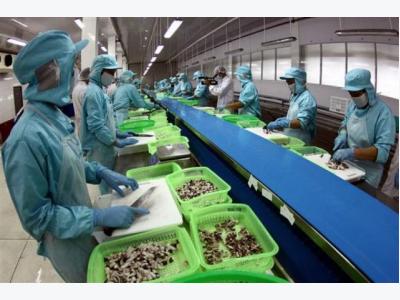Seafood exports to China expected to reach top of billions

China is considered as the emerging market for Vietnam seafood. It is forecast that seafood exports to this market will exceed $US 1 billion in 2017.
Shrimp exports to China rose 23% in 2016. Photo: Ha Phuong
According to the Vietnam Association of Seafood Exporters and Producers(VASEP), besides the major seafood export markets such as the US, EU, and Japan, China also significantly contributed to export achievements of $US 7.1 billion of the Vietnam Fisheries industry in 2016.
Specifically, shrimp exports to China rose 23%, reaching $US 431 million in 2016. China is the largest market for consumption of Black tiger prawns, accounting for about 58% of Vietnam’s shrimp exports to this market with large imports of fresh/live/frozen Black tiger prawns and some processed shrimp.
Meanwhile, after consecutive months of import increases from Vietnam with growth rate of two numbers, China has passed the EU to become the second largest export market for Tra catfish of Vietnam. The total export turnover of Tra catfish to China in 2016 was estimated at $US 305 million, up nearly 90% compared to 2015.
Mr. Truong Dinh Hoe, the General Secretary of VASEP said, although the market is unstable and risky, it still significantly attracted Vietnam seafood exports due to a dramatic increase in the demand of seafood consumption and imports from China.
Especially, the trend of shrimp consumption of the China market increased as the income of Chinese people rose, while domestic production capacity slowed, the increase of imported shrimp will be the market trend in the coming years.
"With the current growth rate, it is forecast that Vietnam's seafood exports to China will exceed $US 1 billion in 2017," Mr. Hoe said.
However, according to the forecast of VASEP, seafood exports will face the challenges of high prices of material production of Vietnam in 2017.
Accordingly, the shrimp industry and some key seafood products of Vietnam have been recognized and compared to similar industries in India, and Thailand showing that the production price in Vietnam is higher by 10 -30%.
Many factors cause high prices (breeding fish, food, input material, loss after harvest, electric and water costs and administrative costs, etc). These are also important factors affecting the competitiveness of Vietnam seafood in 2017.
Có thể bạn quan tâm
 Expanding the E-cert grant for exporting seafood
Expanding the E-cert grant for exporting seafood After nearly 10 months of pilot issue of E-cert for exporting seafood shipments under the National Single Window
 Responses to incorrect and defamatory information on tra fish bred in the Cuu Long (Mekong)
Responses to incorrect and defamatory information on tra fish bred in the Cuu Long (Mekong) the Vietnam Association of Seafood Producers and Exporters - VASEP & many organizations have reacted to this fabricated information, affecting Vietnam tra fish
 Lithuania looks to strengthen trade links with Vietnam
Lithuania looks to strengthen trade links with Vietnam Lithuania's Ambassador Ina Marciulionyte (Feb. 27) told a business forum in Hanoi that the country’s private sector is excited about strengthening trade links